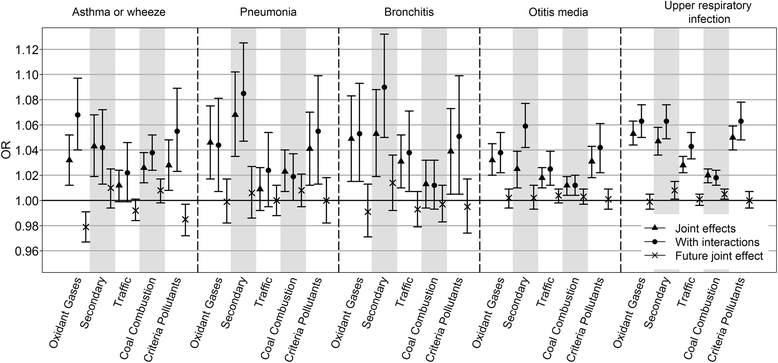Pediatric emergency department visits and ambient Air pollution in the U.S. State of Georgia: a case-crossover study
- PMID: 27887621
- PMCID: PMC5124302
- DOI: 10.1186/s12940-016-0196-y
Pediatric emergency department visits and ambient Air pollution in the U.S. State of Georgia: a case-crossover study
Abstract
Background: Estimating the health effects of ambient air pollutant mixtures is necessary to understand the risk of real-life air pollution exposures.
Methods: Pediatric Emergency Department (ED) visit records for asthma or wheeze (n = 148,256), bronchitis (n = 84,597), pneumonia (n = 90,063), otitis media (n = 422,268) and upper respiratory tract infection (URI) (n = 744,942) were obtained from Georgia hospitals during 2002-2008. Spatially-contiguous daily concentrations of 11 ambient air pollutants were estimated from CMAQ model simulations that were fused with ground-based measurements. Using a case-crossover study design, odds ratios for 3-day moving average air pollutant concentrations were estimated using conditional logistic regression, matching on ZIP code, day-of-week, month, and year.
Results: In multipollutant models, the association of highest magnitude observed for the asthma/wheeze outcome was with "oxidant gases" (O3, NO2, and SO2); the joint effect estimate for an IQR increase of this mixture was OR: 1.068 (95% CI: 1.040, 1.097). The group of "secondary pollutants" (O3 and the PM2.5 components SO42-, NO3-, and NH4+) was strongly associated with bronchitis (OR: 1.090, 95% CI: 1.050, 1.132), pneumonia (OR: 1.085, 95% CI: 1.047, 1.125), and otitis media (OR: 1.059, 95% CI: 1.042, 1.077). ED visits for URI were strongly associated with "oxidant gases," "secondary pollutants," and the "criteria pollutants" (O3, NO2, CO, SO2, and PM2.5).
Conclusions: Short-term exposures to air pollution mixtures were associated with ED visits for several different pediatric respiratory diseases.
Keywords: Air pollution; CMAQ; Multipollutant model; Pediatric Emergency Department Visits.
Figures

Similar articles
-
Effects of short-term exposure to air pollution on hospital admissions of young children for acute lower respiratory infections in Ho Chi Minh City, Vietnam.Res Rep Health Eff Inst. 2012 Jun;(169):5-72; discussion 73-83. Res Rep Health Eff Inst. 2012. PMID: 22849236
-
Air pollution and emergency department visits for otitis media: a case-crossover study in Edmonton, Canada.Environ Health Perspect. 2010 Nov;118(11):1631-6. doi: 10.1289/ehp.0901675. Environ Health Perspect. 2010. PMID: 20663739 Free PMC article.
-
Air pollution and emergency department visits for conjunctivitis: A case-crossover study.Int J Occup Med Environ Health. 2016;29(3):381-93. doi: 10.13075/ijomeh.1896.00442. Int J Occup Med Environ Health. 2016. PMID: 26988878
-
Short-term exposure to ozone, nitrogen dioxide, and sulphur dioxide and emergency department visits and hospital admissions due to asthma: A systematic review and meta-analysis.Environ Int. 2021 May;150:106435. doi: 10.1016/j.envint.2021.106435. Epub 2021 Feb 15. Environ Int. 2021. PMID: 33601224
-
The impact of air pollutants on ambulance dispatches: A systematic review and meta-analysis of acute effects.Environ Pollut. 2019 Nov;254(Pt A):112769. doi: 10.1016/j.envpol.2019.06.065. Epub 2019 Jun 20. Environ Pollut. 2019. PMID: 31419665
Cited by
-
Long-Term Effects of Ambient Particulate and Gaseous Pollutants on Serum High-Sensitivity C-Reactive Protein Levels: A Cross-Sectional Study Using KoGES-HEXA Data.Int J Environ Res Public Health. 2022 Sep 14;19(18):11585. doi: 10.3390/ijerph191811585. Int J Environ Res Public Health. 2022. PMID: 36141854 Free PMC article.
-
Association between Ambient Air Pollution and Emergency Room Visits for Pediatric Respiratory Diseases: The Impact of COVID-19 Pandemic.Toxics. 2022 May 14;10(5):247. doi: 10.3390/toxics10050247. Toxics. 2022. PMID: 35622660 Free PMC article.
-
Associations of mobile source air pollution during the first year of life with childhood pneumonia, bronchiolitis, and otitis media.Environ Epidemiol. 2018 Mar;2(1):e007. doi: 10.1097/EE9.0000000000000007. Environ Epidemiol. 2018. PMID: 30215038 Free PMC article.
-
Association of Air Pollution with the Number of Common Respiratory Visits in Children in a Heavily Polluted Central City, China.Toxics. 2023 Sep 28;11(10):815. doi: 10.3390/toxics11100815. Toxics. 2023. PMID: 37888666 Free PMC article.
-
Effect of PM2.5 Levels on Respiratory Pediatric ED Visits in a Semi-Urban Greek Peninsula.Int J Environ Res Public Health. 2021 Jun 12;18(12):6384. doi: 10.3390/ijerph18126384. Int J Environ Res Public Health. 2021. PMID: 34204762 Free PMC article.
References
-
- EPA D. Integrated science assessment for particulate matter. DC: US Environmental Protection Agency Washington; 2009. - PubMed
-
- Strickland MJ, Darrow LA, Klein M, Flanders WD, Sarnat JA, Waller LA, Sarnat SE, Mulholland JA, Tolbert PE. Short-term associations between ambient air pollutants and pediatric asthma emergency department visits. Am J Respir Crit Care Med. 2010;182(3):307–16. doi: 10.1164/rccm.200908-1201OC. - DOI - PMC - PubMed
MeSH terms
Substances
Grants and funding
LinkOut - more resources
Full Text Sources
Other Literature Sources
Medical

